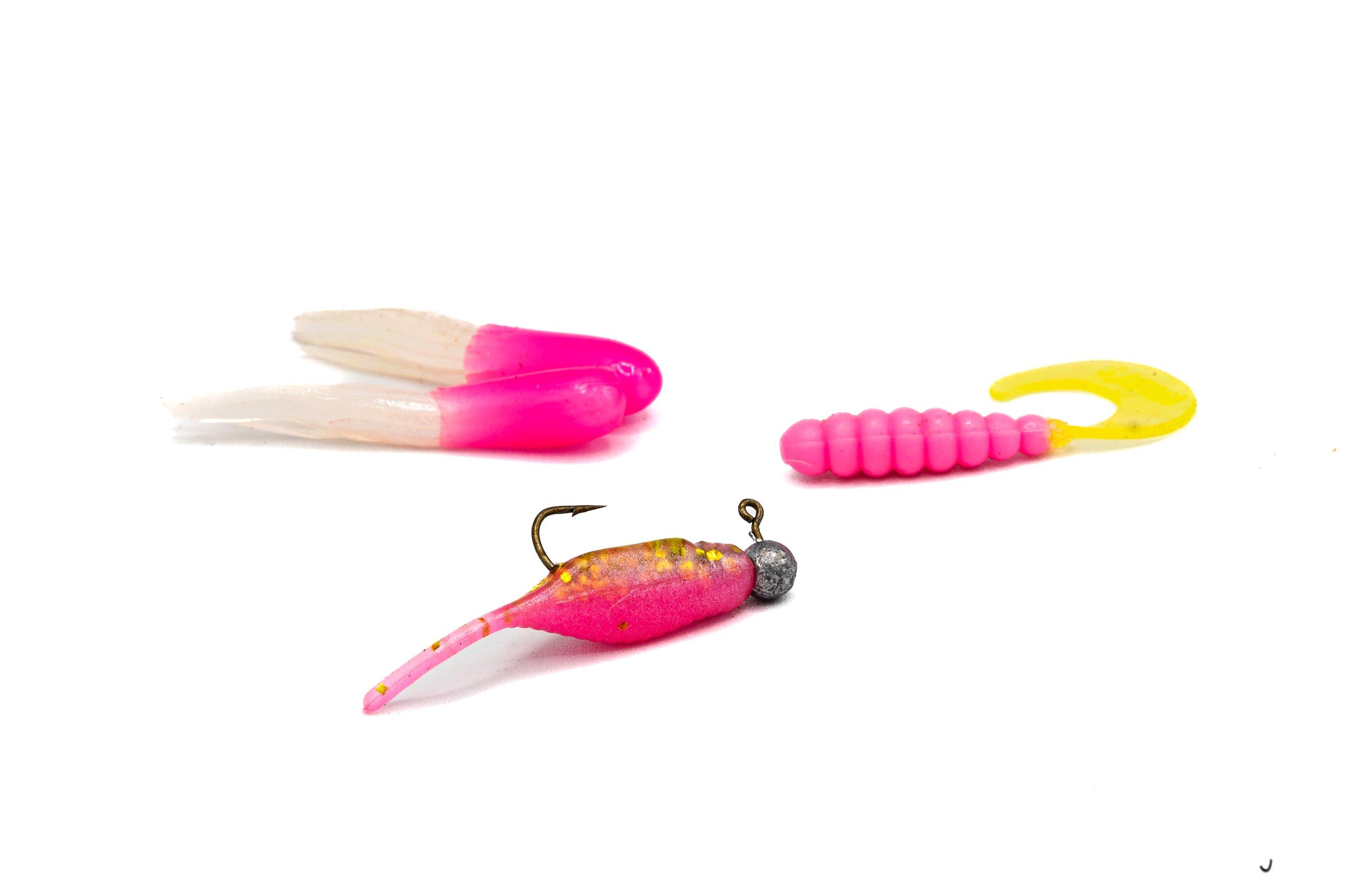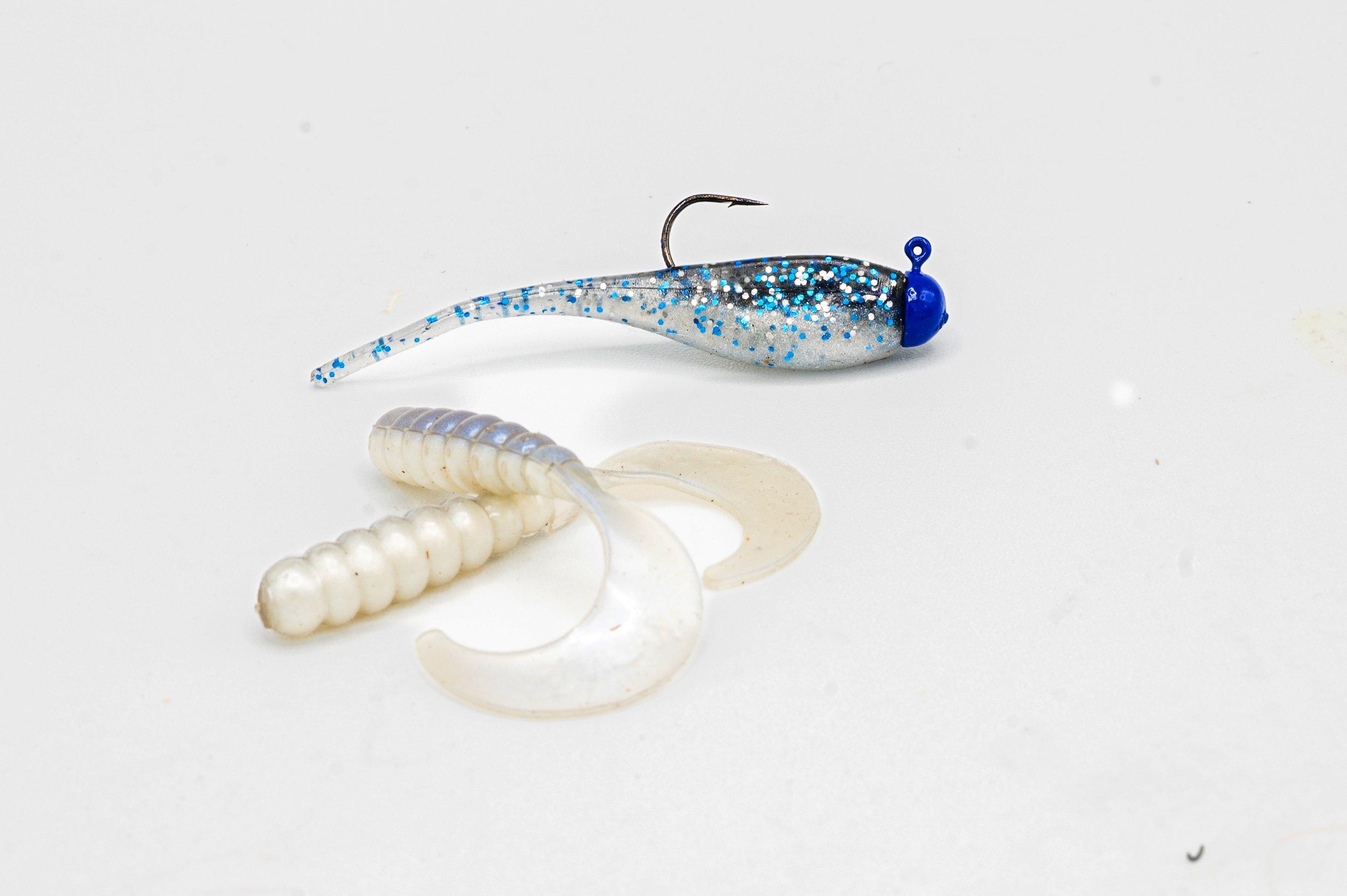Some days, it seems crappies bite the crazy colors best. Here’s why

Crappie fishing is a multi-faceted adventure, and requires a firm understanding of many things, including the different jig colors. Image by Bill Konway
Soft plastic lures come in a variety of colors. Usually, realistic shades matching prey species produce best for most fish, with brighter hues reserved for dirty water or other scenarios calling for high visibility. Minnow, shad, and crawfish colors tend to be the biggest sellers in tackle stores.
A strange exception occurs with crappie anglers. Bubble-gum pinks and loud chartreuse hues are often top picks. Colors with names like Space Monkey and Electric Chicken have become catch phrases. So, what gives? Why does it seem that crappies ignore the rules, and often prefer colors that make no sense? Today we’ll investigate, combining a bit of biology and logic, and taking into consideration the practices of a crappie fanatic.

Use the right color crappie fishing jig, and find more success. Image by Bill Konway
CONSIDER THE CONDITIONS
Before we get too carried away, it’s important to know that crappies frequently still behave like most other freshwater fish in that they’re decidedly picky on bright, sunny days, and prefer tiny baits with the most realistic looks. This is often seen in clear water conditions in fairly shallow water. But winter and summer lulls can also add to a tough bite. Crappies turn picky.
Here, it’s important to understand a key principle to the ways crappies most often feed. Rather than rush out and engulf their prey, like bass, pike, and other ambush-style predators, crappies do a bit more grazing. They have a tendency to study their quarry before eating it. This explains why the subtlest of movements trigger fish in ultra-cold water, or why trollers often find a boat-turn triggers a bite. The fish are studying and following the lure.
More on this can be explained by the diet of the fish. While crappies often eat small minnows, they also frequently consume invertebrates, including aquatic insects. In many parts of the South, tiny grass shrimp make up a large percentage of their diet. Crappies consume small crayfish from around aquatic plants and rocks, even worms and tadpoles. I’ve watched them slowly pluck bugs off dock floats.
In these circumstances, crappies meticulously study their prey. In fact, while using a depthfinder, it’s common to watch the fish approach a lure, follow it up and down, and scrutinize for several seconds before either hitting or turning away. Is it the color that the crappies are analyzing? Could be.
In any case, this helps explain why minute details often turn a lackluster day into a catch-fest. On many occasions — most, really — one particular color will outshine the rest.

Crappie anglers are unique among the freshwater crowd for their love of pink lures. Image by Millennium Promotions
Don’t Miss: PRO TIPS FOR KEEPING FISH ALIVE IN LIVEWELLS
Crappies are sight-feeders, no doubt. They seem to utilize other senses less than most fish. Scent doesn’t seem to be a factor like it is with catfish. And unlike bass, crappies don’t often key in to hard-vibrating lures. In fact, the slightest difference in detail is often a key consideration when fishing for crappies, more than other freshwater fish, as their large eyes investigate every meal.
Another variable to consider again boils down to the lifestyle of the fish. The majority of crappies are caught by presenting a bait at their level, or slightly above. Crappies approach from below, constantly looking up, and suck in our offering. The lure is silhouetted against an open-water backdrop.
For that reason, different colored baits must look drastically different to the fish, to some degree. Also factor in water color. The outline of a black or pink or silver lure may not be that distinct in a dark lake.
A case in point: my home waters of the St. John’s River are uniquely Floridian. Tannic stains turn the river dark year around. The Black Water Inn is a favorite watering hole up the road; this is the classic southern swamp look.
My view of a pink-colored lure above the water is nothing like what a crappie sees 5 feet down. There, the darkness likely tones the lure down quite a bit, perhaps producing a more seductive glow. In fact, when I test the baits boat side, and drop them down a half-foot, I already see a drastic difference.
Silhouetting against a backdrop, usually open water that varies greatly in transparency and hue, may explain the crappie’s affinity for wild-colored baits. Again, other attracting qualities like rattles, wiggles, and bottom-thumping noises aren’t really a consideration when using a jig-and-plastic.

Crappie fishing becomes easier when you match the proper jig to the current conditions. Image by Bill Konway
A PRO’S PERSPECTIVE
Let’s ask our crappie junky. Most of you know Realtree Fishing pro Mark Rose as one of the most successful professional bass fishermen in the country. Dominating the professional leagues, Rose is one of few anglers to surpass $3 million in career earnings. But Rose’s real passion — and most of his efforts — come chasing specks.
“I’ve spent more time in my life crappie fishing than bass fishing,” Rose insists. This is hard to believe, coming from a guy who’s fished professionally for over 25 years. “When it comes to crappies, I go all day, all throughout the year.”
Rose loves experimenting with new lures and colors. However, his tacklebox is mostly filled with a few staples. “Black, red and lime colors, all with a chartreuse tail, are my primary colors in stained water. They glow in those conditions. Blue Glimmer and Blue Ice are used when the water is clear,” he says. Rose is a die-hard Strike King user, preferring the company’s Lightning Shad and Joker shapes. He fishes each on a light jighead, again, often above the fish in open-water environments.
“I have seen when wild colors get the most bites, even in clear water. If the fish are aggressive, that’s one time for sure. Otherwise, when I fish on cloudy days or around boat docks, I always try something out of the norm.” Rose believes that each condition gives crappies a different look at his lure in the reduced light. Then, crappies often go crazy for something gaudy.

Clear-water lure colors tend to be translucent, featuring silver and shades of blue. Image by Millennium Promotions
Don’t Miss: SALMON SHARK DISCOVERED ON SHORE OF IDAHO RIVER LIKELY A PRACTICAL JOKE
Even the shades of colors can make a difference. Chartreuse, for example, can be pale and fairly transparent, or bold and bright, like an opaque shade of white. Same for pink. I often use a bright chartreuse tail, though a bit see-through, in high sun with great results. Perhaps the translucence of the color is what really matters.
In the end, we may never know. And maybe we’re overthinking it. Do specific colors really make that much of a difference?
“Oh, absolutely,” insists Rose. “They most definitely make a difference. My general rule of thumb is to stick to my basics, but never rule out an odd-ball.” For that reason, most avid crappie anglers know to rig their favorite rod, then rig another. A single cast with an underdog can change the entire course of the day.
Fishing for crappies with plastic baits is a blast. The vast array of colors, shapes, and sizes always keeping us thinking and tinkering. That’s the best part: knowing that you may be just one switch away from a memorable outing.
Or one more trip to the tackle shop.
Don’t Miss: 10 SURPRISING TIMES WHEN WEARING CROCS IS APPROPRIATE










